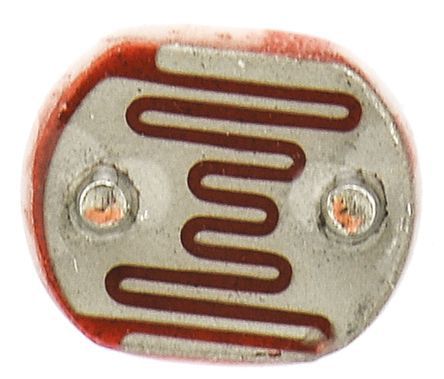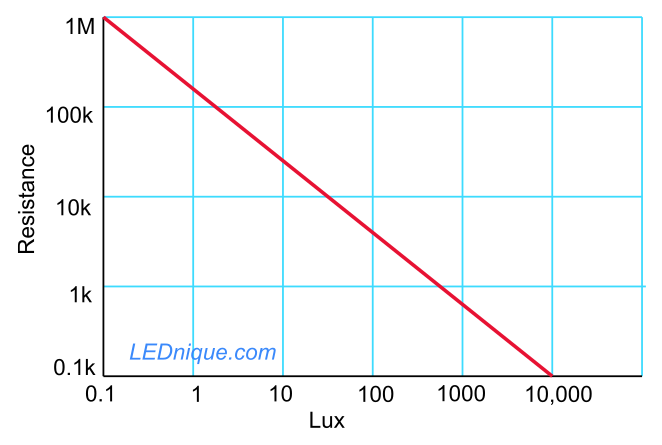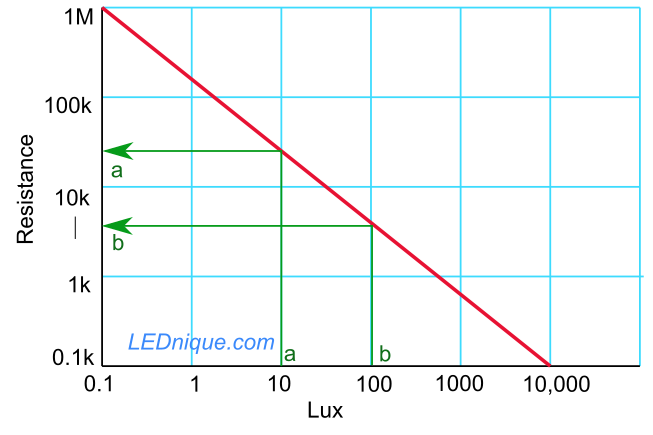LDR Summary
- LDRs are light dependent resistors.
- Resistance decreases with increasing light levels.
- Typically > 1 MΩ when dark and < 1 kΩ in high light levels.
- Response time of 2 – 50 ms. (Much slower than photo-transistors.)
- They have a “light history”. Characteristics change a little as they acclimatise after long periods in darkness.
- LDRs are more sensitive to certain wavelengths (colours). The CdS types are most sensitive to green.
Details
LDRs, light depenedent resistors or photo-resistors are often used with LED circuits as simple photo-detectors.

In dark conditions the resistance between the terminals is high – up to 1 MΩ or so. The resistance falls with increasing light levels down to a few hundred ohms at high brightness.


| Lighting condition | From (lux) | To (lux) | Mean value (lux) |
|---|---|---|---|
| Pitch Black | 0 | 10 | 5 |
| Very Dark | 11 | 50 | 30 |
| Dark Indoors | 51 | 200 | 125 |
| Dim Indoors | 201 | 400 | 300 |
| Normal Indoors | 401 | 1000 | 700 |
| Bright Indoors | 1001 | 5000 | 3000 |
| Dim Outdoors | 5001 | 10,000 | 7500 |
| Cloudy Outdoors | 10,001 | 30,000 | 20,000 |
| Direct Sunlight | 30,001 | 100,000 | 65,000 |
Spectral response

The common CdS (cadmium sulfide) LDRs have peak spectral response at about 550 nm which is the green region of the visible spectrum. Note that if illuminating the LDR with an LED that a red LED might give only about 30% of the response of a green LED on the same current.
Understanding the datasheet
The Luna datasheet for the NSL-19M51 gives the following figures.

- Note the wide variation in resistance at 10 lux – 20 to 100 kΩ.
- Note a “typical” resistance at 100 lux of 5 kΩ.
- Note that maximum dark resistance is specified for 10 s after removal of light. This suggests that the device response is slow.
- The gamma characteristic is a measure of the slope of the resistance versus lux relationship. (See below.)
LDR gamma characteristic

LDR gamma characteristic is a measure of the rate of change of resistance over range of light variation. Typically the gamma is specified for the range 10 to 100 lux and calculated as
$$ \gamma = \frac {log( \frac {R_{10}}{R_{100}}) }{log( \frac {100}{10}) } = log( \frac {R_{10}}{R_{100}}) $$
since log(10) = 1.
In our case we can estimate that a is about 25k divisions up and b is about 4k divisions up so
$$ \gamma = log( \frac {R_{10}}{R_{100}}) = log( \frac {25}{4}) = log(6.25) = 0.795$$
Gamma values of 0.6 to 0.8 are common for CdS LDRs. A gamma tolerance of ±0.1 is common.
For the digital ON-OFF applications such as flame detectors, LDRs with steep slopes to their resistance versus light intensity curves are appropriate. For analog or measurement types of applications such as exposure controls for cameras, LDRs with shallow slopes may be better suited.
Response times

The slow response times of LDRs makes them unsuitable for data transmission, for example, but can be an advantage in other circuits such as flame detectors or audio effects where the slow response smoothes out the signal being monitored or controlled.
Light history
A photocell which has been stored for a long time in the light will have a considerably higher light resistance than if it was stored for a long time in the dark. Also, if a cell is stored for a long period of time at a light level higher than the test level, it will have a higher light resistance than if it was stored at a light level closer to the test light level. This effect can be minimized significantly by keeping the photocell exposed to some constant low level of illumination (as opposed to having it sit in the dark). This is the reason resistance specifications are characterized after 16 hours light adept. (Source.)









